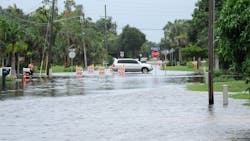Strategic solutions in action: Tackling flooding risks with effective infrastructure investments
Every $1 spent on flood mitigation before disaster strikes yields $6 to $7 in saved recovery costs, according to the Federal Emergency Management Administration (FEMA). Meanwhile, the number of properties in the United States that suffer from repeated flood damage is rising at a staggering rate, the Natural Resources Defense Council says. That is surprising because abundant funding is available for flood mitigation efforts. When flooding is repeated regularly, taxpayers end up footing the bill.
Numerous cities and states are working to rectify this alarming problem. But the question is, why aren’t all states taking action?
Examples across the country
In 2017, a major flooding event occurred in Santa Clara, California, causing thousands of residents to be evacuated and sheltered. Public officials have launched several projects to protect the area from another flood. Now, however, a larger $115 million project is being planned to further reduce the risk of another major flooding event.
The project will include additional levees, floodwalls and passive barriers along 9 miles of Coyote Creek. It will include minimal or no stream-channel changes to ensure the natural habitat will be protected, and it will also include revegetation measures to replace all soil and plant growth lost during construction. An environmental impact study has been concluded, and community input has been received. The last hurdle is to complete the final design work so construction can begin in mid-2025.
In Houston, a $131 million canal project is planned. A partnership between the Texas Department of Transportation, the city of Houston, Harris County Flood Control District and Memorial Heights Redevelopment Authority will support the effort to address flooding risks. The project, now in the design phase, has three specific areas that will be designed to address flooding and provide more resilient infrastructure. Project components will include a high-flow diversion channel, an overflow channel and other channel improvements. Plans also include project enhancements to the public space, such as open green areas and walking or biking trails. This project is experiencing a significantly long design phase, with a construction launch slated for 2026. It will be partially funded through FEMA’s Hazard Mitigation Grant Program. When completed, the result will be much lower flood water levels in the city’s downtown area and surrounding upstream areas.
The Red Hook Coastal Resiliency Project, situated in the Red Hook neighborhood of Brooklyn, is a $100 million initiative that will be designed to bolster the area’s defense against coastal flooding. The objective is to protect against Red Hook’s vulnerability to storm surges and rising sea levels. Funding will come from the city of New York, FEMA and the state’s Department of Emergency and Homeland Security Services. The project will include construction of robust flood walls and deployable gates designed to withstand rising water levels. Construction launch is slated for 2025.
In partnership with the University of Colorado Boulder and the Mile High Flood District, city officials in Boulder will invest $61 million in a flood mitigation project. The initial effort will represent the first of three phases of work to be done on South Boulder Creek’s major drainageway, which is prone to severe flooding. Facets of the project include constructing an embankment dam, a structural spillway wall, an outlet tunnel that will pass underneath US Route 36, detention excavation and restoration of the surrounding ecosystems. The dam will be a zoned earth-fill embankment that includes infernal fibers and drains and a barrier wall in the foundation to manage seepage. Construction is scheduled to begin in 2025.
The Philadelphia Water Department will use $15 million to expand the capacity of the Northeast Water Pollution Control Plant in Port Richmond to prevent it from being inundated during flooding events. Currently, the wastewater plant cleans up to 650 million gallons of water per day before releasing it to the Delaware River. Still, increased water flow during storms can overwhelm the plant’s capacity and cause untreated sewage to be released into the river. Once the project is completed, the facility's expansion will allow the plant to withstand flooding up to the 100-year storm event. These additions will increase the capacity to handle an additional 300 million gallons of water per day from the Frankford High-Level Sewer during a storm. The water will be screened to remove grit and then sent to primary sedimentation tanks for primary treatment. The design work for this project has been completed, and solicitations for construction services are anticipated soon. Planning documents indicate the effort should be completed by 2026.
Conclusion
Flooding creates devastating chaos and cost. Projects like these will result in long-term sustainability, greater citizen safety and significant cost savings. Contractors interested in pursuing such opportunities are advised to establish their capabilities early on so they can be considered when contracting decisions are made.
About the Author
Mary Scott Nabers
President and CEO of Strategic Partnerships, Inc.
Mary Scott Nabers is CEO of Strategic Partnerships, Inc. and the author of Inside the Infrastructure Revolution – A Roadmap for Rebuilding America.


